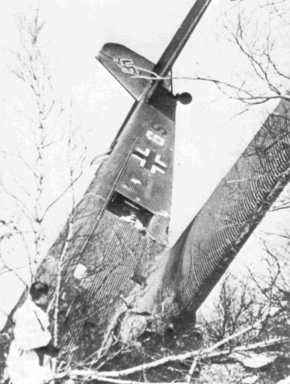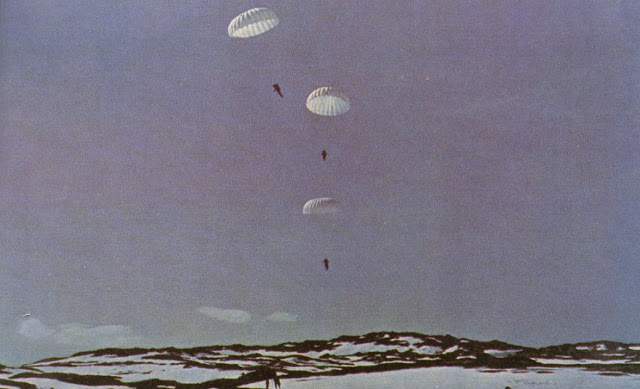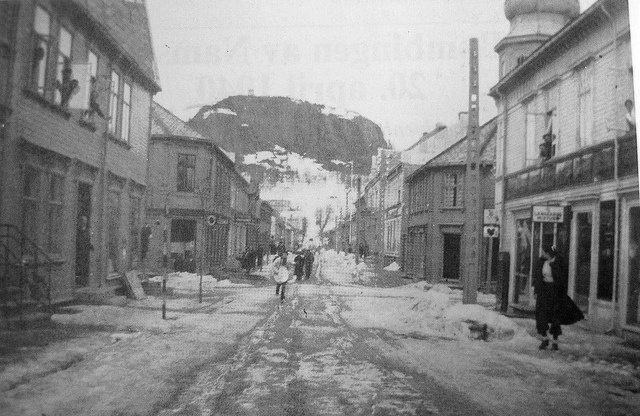Sunday 14 April 1940
 |
| One of the Junkers Ju 52 transport planes shot down during the Dombås paratrooper operation, 14 April 1940. |
The British and French are unsure how to proceed. However, they are agreed that they have to do... something. The decision comes down to getting some troops ashore and then figuring out what to do with them later. So, troops land in Norway, but far away from any opposition.
Norway Army Operations: The Germans are advancing north from Oslo through the Glomma Valley, and the Norwegians are delaying them wherever possible. The German 196 Infantry Division pushes northward from Oslo, and about 3000 Norwegian troops in the sector head across the border into Sweden and are interned.
 |
| A different German parachute drop in Norway, probably up at Narvik. |
The initial objective at Dombås is the destruction of the railroad which runs through the town, as well as blocking any Allied advance inland, particularly south through the Gudbrandsdal valley. Schmidt blocks the main road in the area, cuts the rail line and cuts the phone wires, then captures a passing taxicab. Piling as many men into it as possible, Schmidt and the men head north to Dombås.
Along the way, Schmidt's taxi runs into two truckloads of Norwegian soldiers coming the other way. A firefight breaks out, and Schmidt's advance is stopped. He takes up a defensive position near the main road - thus blocking it - and waits for his other men coming along behind (walking) to catch up. The attack is a fiasco for the men involved, and Schmidt is badly wounded while retaining command - but there is more to the story.
The attack has some important results: it causes the Norwegians to evacuate the national gold reserves to Britain immediately by fishing boats and British cruisers. Schmidt also, despite everything, has blocked a key road, disrupted Norwegian communications and delayed Norwegian mobilization plans. Perhaps most importantly, he has sowed terror and confusion throughout the Norwegian government and military - everyone throughout the country soon is talking about "German paratroopers" and looking over his or her shoulder.
 |
| Dombås paratroopers, 14 April 1940. |
British infantry troops then land at Harstad, near Narvik, and at Namsos, just north of Trondheim. The Namsos troops of the 146th Territorial Brigade, which have been embarked since 11 April, intend to consolidate in the Namsos and Andalsnes sectors. Execution of the operation is confused, as the 146 Territorial Brigade first is sent toward Narvik, but then is diverted south to attack Trondheim due to Vice Admiral Whitworth's (HMS Warspite) belief that Trondheim will be easy to take. The landing force's artillery, anti-aircraft guns, and commanding officer don't get the message and continue north to Narvik.
The troops at Harstad also are pointed at Narvik, the one true strategic objective in northern Norway.
The Admiralty announces that it is mining the entire Kattegat and parts of the Baltic, with the exception of a 3-mile territorial belt around Sweden.
Royal Navy submarine HMS Tarpon torpedoes and sinks Kriegsmarine minesweeper M-6.
Royal Navy submarine HMS Snapper torpedoes and sinks German cargo ship Florida.
Royal Navy Ship HMS Sunfish torpedoes and sinks Kriegsmarine ship Schiff-35.
Royal Navy submarine HMS Sterlet torpedoes and sinks Kriegsmarine training ship Brummer (sinks on 15 April).
Convoy OA 129 departs from Southend, Convoy OB 129 departs from Liverpool, Convoy OG 26F forms at Gibraltar, and Convoy HX 35 departs from Halifax.
Norway Air Operations: At dawn, the RAF bombs Stavanger-Sola airfield and the seaplanes in Hafrs Fjord. Some damage is done to the hangars.
The Norwegian air force, which has old Fokker biplanes, bombs the Junkers Ju 52 transport planes landing on Lake Hartvigvann to supply the Mountain troops holding Narvik.
RAF Bomber command sends 28 aircraft to lay mines off the Danish coast during the night.
Holland: The military extends the areas covered by the state of siege in the northern part of the country.
Future History: It is easy to make fun of the Battle of Dombås and call it a failure and so forth. However, the men of the 7th Flieger Division accomplished exactly what the paratroopers of 6 June 1944 did in Normandy - they dropped at random in the enemy rear, disrupted enemy operations, and sowed confusion and terror behind the lines despite not accomplishing all of their formal objectives. Nobody ever says that the paratroopers of D-Day were a failure.
April 1940
April 1, 1940: Weserubung is a GoApril 2, 1940: British Subs On Alert
April 3, 1940: Churchill Consolidates Power
April 4, 1940: Missed the Bus
April 5, 1940: Mig-1 First Flight
April 6, 1940: Troops Sailing to Norway
April 7, 1940: Fleets At Sea
April 8, 1940: HMS Glowworm and Admiral Hipper
April 9, 1940: Invasion of Norway
April 10, 1940: First Battle of Narvik
April 11, 1940: Britain Takes the Faroes
April 12, 1940: Germans Consolidate in Norway
April 13, 1940: 2d Battle of Narvik
April 14, 1940: Battle of Dombås
April 15, 1940: British in Norway
April 16, 1940: Germans Cut Norway in Half
April 17, 1940: Trondheim the Target
April 18, 1940: Norway Declares War
April 19, 1940: Dombås Battle Ends
April 20, 1940: Germans Advancing in Norway
April 21, 1940: First US Military Casualty
April 22, 1940: First British Military Contact with Germans
April 23, 1940: British Retreating in Norway
April 24, 1940: British Bombard Narvik
April 25, 1940: Norwegian Air Battles
April 26, 1940: Norwegian Gold
April 27, 1940: Allies to Evacuate Norway
April 28, 1940: Prepared Piano
April 29, 1940: British at Bodo
April 30, 1940: Clacton-on-Sea Heinkel
2019





